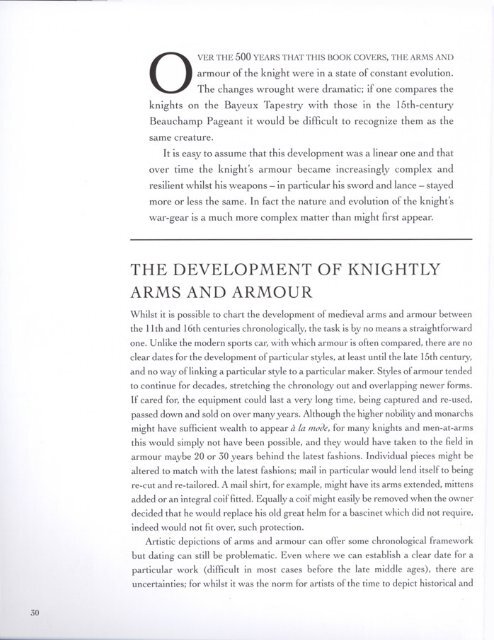Osprey - General Military - Knight - The Warrior and ... - Brego-weard
Osprey - General Military - Knight - The Warrior and ... - Brego-weard
Osprey - General Military - Knight - The Warrior and ... - Brego-weard
You also want an ePaper? Increase the reach of your titles
YUMPU automatically turns print PDFs into web optimized ePapers that Google loves.
OVER THE 500 YEARS THAT THIS BOOK COVERS, THE ARMS AND<br />
armour of the knight were in a state of constant evolution.<br />
<strong>The</strong> changes wrought were dramatic; if one compares the<br />
knights on the Bayeux Tapestry with those in the 15th-century<br />
Beauchamp Pageant it would be difficult to recognize them as the<br />
same creature.<br />
It is easy to assume that this development was a linear one <strong>and</strong> that<br />
over time the knight's armour became increasingly complex <strong>and</strong><br />
resilient whilst his weapons — in particular his sword <strong>and</strong> lance — stayed<br />
more or less the same. In fact the nature <strong>and</strong> evolution of the knight's<br />
war-gear is a much more complex matter than might first appear.<br />
THE DEVELOPMENT OF KNIGHTLY<br />
ARMS AND ARMOUR<br />
Whilst it is possible to chart the development of medieval arms <strong>and</strong> armour between<br />
the 11th <strong>and</strong> 16th centuries chronologically, the task is by no means a straightforward<br />
one. Unlike the modern sports car, with which armour is often compared, there are no<br />
clear dates for the development of particular styles, at least until the late 15th century,<br />
<strong>and</strong> no way of linking a particular style to a particular maker. Styles of armour tended<br />
to continue for decades, stretching the chronology out <strong>and</strong> overlapping newer forms.<br />
If cared for, the equipment could last a very long time, being captured <strong>and</strong> re-used,<br />
passed down <strong>and</strong> sold on over many years. Although the higher nobility <strong>and</strong> monarchs<br />
might have sufficient wealth to appear a la mode, for many knights <strong>and</strong> men-at-arms<br />
this would simply not have been possible, <strong>and</strong> they would have taken to the field in<br />
armour maybe 20 or 30 years behind the latest fashions. Individual pieces might be<br />
altered to match with the latest fashions; mail in particular would lend itself to being<br />
re-cut <strong>and</strong> re-tailored. A mail shirt, for example, might have its arms extended, mittens<br />
added or an integral coif fitted. Equally a coif might easily be removed when the owner<br />
decided that he would replace his old great helm for a bascinet which did not require,<br />
indeed would not fit over, such protection.<br />
Artistic depictions of arms <strong>and</strong> armour can offer some chronological framework<br />
but dating can still be problematic. Even where we can establish a clear date for a<br />
particular work (difficult in most cases before the late middle ages), there are<br />
uncertainties; for whilst it was the norm for artists of the time to depict historical <strong>and</strong>







